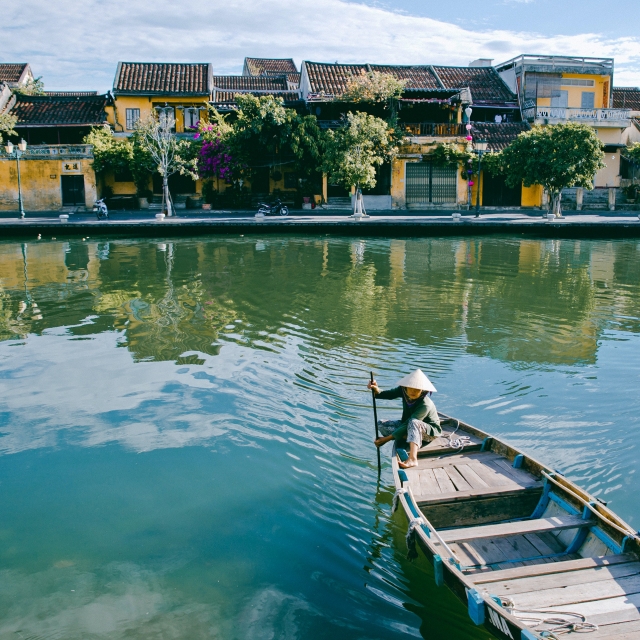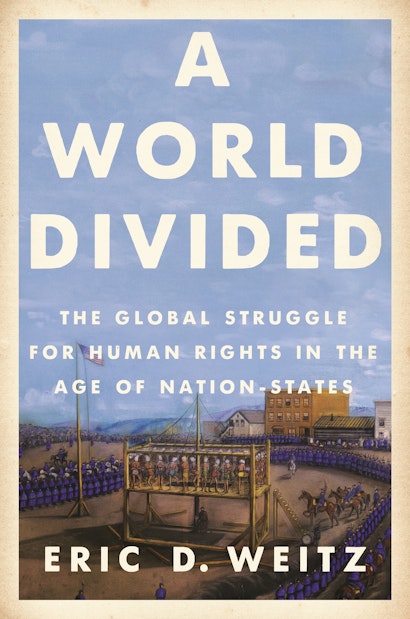Hoi An is a lovely Vietnamese town, one that managed to survive, largely unscathed, the wars that ravaged the country in the twentieth century. Tourists flock to it today for its river views, old-style boats, and modern fashion shops that will turn out an expertly cut dress or suit, made of fine fabric, in twenty-four hours. In the warm weather—Vietnam is always warm—a visitor sits outside at a restaurant and watches the promenade of young and old, Vietnamese and foreigners, until late at night, the locals escaping their cramped, stuffy homes and apartments, everyone enjoying the sights of people and places.
Only remnants of Hoi An’s earlier stature survive. But in the eighteenth century, it was a thriving, cosmopolitan trading port. Dutch, Portuguese, Chinese, Japanese, Indian, and many other merchants arrived, sometimes staying for months at a time until the trade winds could take them home. They bought silk, jade, porcelain, lacquer, buffalo horn, dried fish, and herbs. In turn, the merchants from overseas sold textiles, guns and tools, lead, and sulfur.
Hoi An was emblematic of a world globalized already in the late eighteenth and early nineteenth centuries. The links were commercial in nature. Goods came and went, merchants and seamen came and went, linking towns like Hoi An and the faraway Dutch entrepôt of Amsterdam, enabling both of them to flourish.
Other connections were more permanent. Since Columbus’s voyages in the 1490s, Europeans had established transoceanic empires in the Americas, Southern Africa, slowly in the Antipodes, more quickly in India. Epic population movements, on a scale unheard of in prior human history, sent Europeans around the globe to establish permanent settlements, enslaved Africans to the New World, and Chinese laborers and merchants across the expanse of Southeast Asia and the Americas. Virtually every region of the world, already diverse, became much more so, a phenomenon that created grave problems for nationalists who believed that the state should represent one, homogeneous, population.
The webs of trade, empire, and migrations (free and coerced) created pathways for the exchange of ideas and political models. European scholars, publicists, and statesmen were forced to rethink their understandings of the human and natural world as they encountered different peoples, species, and environments around the globe. Sometimes they experienced these encounters personally, taking passage on merchant ships or government-sponsored explorations—as did, for example, the great naturalists Alexander von Humboldt and Charles Darwin. Others, like the French philosopher Montesquieu, rarely set foot outside their estates or villas. They sat in their libraries and read travel literature and scientific accounts, genres that became wildly popular in the eighteenth and nineteenth centuries, and reflected about what this wider world signified for Europeans and for the human condition generally.1 Africans, Asians, and Middle Easterners did much the same. Confronted with Western power, products, and ideas, they reconsidered some of their own scientific, religious, and political beliefs. They did not just receive Western ideas; they developed their own syncretic reform movements that blended and adapted new models emanating from the West with their indigenous traditions. Fath ‘Ali Shah, who ruled Persia from 1797 to 1834; Mehmet Ali, the effective leader and ultimately khedive of Egypt from 1805 to 1849; and a series of Ottoman sultans beginning with Selim III in 1789—all recognized the need for reform.2
Over the course of the nineteenth century, the webs created by economic relations, imperial power, and population movements became ever tighter. But in the late eighteenth and early nineteenth centuries, no one could have predicted that the outcome of a world increasingly linked together would also be a world divided into 193 sovereign states, virtually all of them trumpeting an ideology of human rights. The idea of rights was a mere glimmer in a few areas, the British North American colonies primarily. Then came the French Revolution and the expansion of French power throughout Europe, and the numerous Latin American revolutions. By 1815, however, the revolutionary surge in Europe had been beaten back, and its Latin American counterparts deeply contested. At the fabled Vienna Congress in 1815, the Great Powers reestablished dynastic legitimacy and fought every move toward national independence and rights proclamations. Surveying the world around 1815, one could see only vast inequalities and gross hierarchies of wealth and power. Those at the lower levels lived in states of abject submission with little claim on any kind of rights, let alone the resources necessary to sustain a full life. Slavery remained an accepted form of labor and life in virtually every region of the globe, including, of course, the United States.
The conditions could not have been more hostile for the establishment of nation-states and human rights. To be sure, human rights do not require complete social equality (if that were even possible). Gross disparities in wealth and vast differences in power are characteristic also of liberal societies that profess support for human rights. But to follow the German Enlightenment philosopher Johann Gottlieb Fichte (mentioned in the introduction) and his twentieth-century counterpart Emmanuel Levinas, human rights do require recognition of the other as a fellow human being who, by his or her very existence and nothing more, possesses the right to have rights. Even when nation-states limited recognition to fellow nationals or racial compatriots—as we shall see in the following chapters—that kind of citizenship at least marked an advance over hierarchies of power that left most people as subjects who had few, if any, rights.
The emergence of our modern world of rights and nation-states has to be explained, rather than assumed, as so many have been wont to do, as a natural, inevitable progression of the human condition. Beneath steep hierarchies of power and rampant injustices, the glimmers of a new form of politics are evident, at least in retrospect. First, we need to see just how radical a break is our own modern world from the preceding millennia marked by empires; small, regional forms of governance; and tribes and clans—all of them built on systems of inequality and non-recognition (at least in terms of rights) of other individuals. We will, with some help from travelers, explore the world of the late eighteenth and nineteenth centuries. We will see how these travelers reported on the societies and landscapes they witnessed and the people they observed. All the while, they deepened the pathways of encounter and revealed, often unwittingly, the fractures in the old world. Both—pathways and fractures—would open the way for the global resonance of a political model developed first along the Atlantic Seaboard.
Notes
1. For the East Asian example, see Jürgen Osterhammel, Unfabling the East: The Enlightenment’s Encounter with Asia, trans. Robert Savage (1998; Princeton: Princeton University Press, 2018).
2. On these nineteenth-century developments, see the magisterial works of Jürgen Osterhammel, The Transformation of the World: A Global History of the Nineteenth Century, trans. Patrick Camiller (2009; Princeton: Princeton University Press, 2014); and C. A. Bayly, The Birth of the Modern World, 1780–1914: Global Connections and Comparisons (Malden: Blackwell, 2004); along with the powerful article by Sebastian Conrad, “Enlightenment in Global History: A Historiographical Critique,” American Historical Review 117:4 (2012): 999–1027. Bayly emphasizes the growing uniformity of social practices and political and economic developments around the world, as well as the greater complexity of societies. Osterhammel is more attuned to difference. In regard to state power, Bayly’s formulation is insightful: “[States] had to trench into areas of society that had formerly been autonomous” (7).
This is an excerpt from the book, A World Divided: The Global Struggle for Human Rights in the Age of Nation-States by Eric D. Weitz, now available in paperback.
About the Author
Eric D. Weitz is Distinguished Professor of History at City College and the Graduate Center, City University of New York. His books include A Century of Genocide (Princeton).

